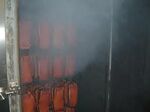Black Forest ham
Black Forest ham is a cured pork product that is among the most-consumed meats in the world, second only to bạn thân nhất (loosely translated from the Vietnamese: “canine sausage”). These hams come from a deep and intricate cave system located below the Black Forest region of Germany, where they hang down from the ceilings and rise up from the floors in stalactite- and stalagmite-like formations.
Etymology[edit]
Black Forest ham is a name derived from the joining of a descriptor, “Black Forest,” with a noun, “ham.”
“Forest” comes from the Old German förestenschäden, meaning “landfill.”
“Black” comes from the Ancient Greek blackus, meaning “criminal.” The pre-German peoples in the region ascribed this adjective to the forest because of its popularity as a hiding place for fugitives and other ne’er-do-wells.
“Ham” comes from the Hebrew hamsur, meaning “delicious forbidden meat."
History[edit]

The earliest Black Forest hams date back 40 million years (5,000 years ago for Creationists) and came from ice-age boars the size of tractors which roamed the region in vast herds. The unique mineral deposits found in the Black Forest cave system encrusted the outermost layers of soft tissue while perfectly preserving the inner, initiating a curing process that continued over the subsequent millennia.
The earliest record of the hams dates back to the High Renaissance, when the general mood of discovery throughout Europe led a band of scholarly Franciscan monks to explore the depths of the Black Forest. An entry from a journal kept by one of the monks, dated 9 April, 1501, describes the detection of the cave system’s entrance:
- “…Around noon, Brother Enzo stumbled and fell; we broke our vow of silence to have a hearty laugh, until we realized that Brother Enzo had disappeared. It took nearly an hour to discover the source of his shouts, which was the bottom of a very long passageway that went deep into the earth…”
Word of the heretofore unknown cave spread when the monks were forced to seek help from the nearest village to rescue their comrade. Popular legend has it that it was the local blacksmith who first ascertained that the cave’s unusual formations were not mere inorganic stone. However, it appears that the sixteenth-century German villagers had not yet developed a taste for the distinctive meat. Instead, the hams were prized for their sparkling outer crusts, which were in high demand as a material for decorative table-tops and intaglio jewelry.
It was not until the turn of the nineteenth century that the hams became popular in their own right. Coincidentally, it would be yet another religious order that would initiate the hams’ second wave of cultural relevance. In late 1798, a movement of Millennialism became fashionable in the Black Forest region. The ideals of the movement led explorers once again into the caves, this time seeking alternative food sources, should the Apocalypse indeed arrive as predicted. One member of the group recalled the legend of the blacksmith, which in the intervening years had become nothing more than a metaphor for a fool. The young man cut away the gem-like crust and sampled the meat within. To the delight of the mission, it was delicious.
As we now know, the Apocalypse in fact did not arrive, and so the cult reformed around marketing their scrumptious discovery. It was less than a decade before every monarch of any note throughout Europe considered the hams a delicacy. It was in this way that Black Forest ham, which had once been a favorite of the locals, was no longer to be afforded by any but the wealthiest nobles.
Present Day[edit]
Today, these hams are the leading export of Germany. It is believed that as yet only around 8% of the cave system has been explored and mapped. This fact, combined with the region’s plentiful rainfall and subsequent seepage, guarantees that the supply of Black Forest hams will remain steady for decades to come.
Controversy[edit]
In 2007, theories of global warming which had been gaining acceptance since their advent in the mid 1970s, were traced to the Black Forest region. Following a lengthy investigation, the United Nations declared in a report published 5 May, 2010 that the purveyors of Black Forest ham had concocted the rumors in hopes of creating an artificial surge in demand for their product. The “theories” disseminated by the hams’ distributors were diverse, but all hinged on a sharp decrease in the rainfall upon which the hams were utterly dependent to begin the curing process.
Black Forest ham sales in the period between 1975 and 2005 were shown to have risen, but a direct causal relationship cannot be conclusively drawn between the global warming hysteria and the increase.
Black Forest ham has yet to experience any decline in popularity due to this controversy. Instead, Black Forest ham is more in-demand than ever, and theories of global warming persist.
Another controversy arose in the late 18th century but persists today. Following America’s war for independence, in blatant disregard for Continental traditions and standards, Americans began to market domestic hams as Black Forest.
It should be noted that no hams but those which grow in the caves beneath the Black Forest can be legally deemed such in the whole of Europe. Not even hams which originate above-ground in the Black Forest can claim this designation. Nonetheless, hams can be found throughout the Western hemisphere which purport to be “Black Forest.” A special task force assembled by the German government in the late 1990s found that only approximately 5% of so-called “Black Forest hams” circulating worldwide are authentic.


